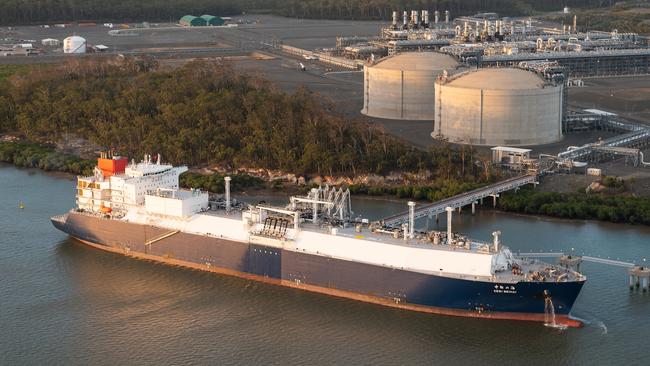Australia in ‘photo finish’ as world’s biggest LNG exporter for 2022, but likely to lose that title
The value of Australian LNG exports surged more than 85 per cent in 2022, but the nation is set to slip behind the US and Qatar.

The value of Australian LNG exports surged more than 85 per cent to almost $93bn in 2022 as gas prices soared amid the European energy crisis.
Record Australian exports of about 81.4 million tonnes of LNG put the local industry in a “photo finish” with the US and Qatar for the title of the world’s biggest exporter, according to analysis of ship-tracking data by consultancy EnergyQuest.
But Australia’s LNG industry is likely to lose that crown in 2023, EnergyQuest chief executive Graeme Bethune said on Thursday, amid falling output from some older Australian assets and uncertainty over how the federal government’s intervention into gas markets will play out.
Domestic gas prices on the east coast surged during the winter energy crisis in the National Electricity Market, prompting an unprecedented intervention by the market operator to cap spot pricing at $40 a gigajoule as some energy retailers collapsed after failing to hedge gas contracts.

Gas prices also soared on international markets amid disruption due to Russia’s war in Ukraine and concerns about energy availability in the Northern hemisphere winter.
European gas futures on the Dutch TTF exchange peaked at €345.50 a megawatt hour in August, and LNG futures on the Japan-Korea Marker peaked above $US80 per mmbtu at around the same time. While most Australian LNG producers sell only a small portion of their cargoes into spot markets, surging gas prices still led to record export, according to Dr Bethune, with analysis suggesting revenue lifted 86 per cent to about $92.8bn.
“The highly cyclical nature of LNG revenue is demonstrated by the fact that during the peak of the pandemic in 2020 LNG export revenue was only $36 billion,” Dr Bethune said. “The huge growth in export revenue in 2022 is set to drive strong growth in taxation and royalties paid by Australian LNG projects, as well as helping pay for Australia’s imports.”
But whether those export records – both volume and value – will be maintained is doubtful.
A mild European winter has seen concerns about gas pricing ease, with gas futures sold on the TTF exchange worth €65.02 a megawatt hour on Thursday evening – below pricing levels in February, ahead of Russia’s invasion of Ukraine. Gas was trading on the JKM for about $US29.50 on Thursday night.
And Dr Bethune said Australian export volumes were also likely to fall, with Australia likely to be surpassed by both the US and Qatar in 2023.

“The rapid growth in US exports since 2016 shows the flexibility of the US energy market, particularly its ability to respond quickly to global crises such as the cuts in Russian gas supplies to Europe. Ironically US LNG exports are based on fracture-stimulated shale gas, the development of which is widely banned in Europe and is politically controversial in Australia,” he said.
“The challenges of gas development in Australia are shown by the fact that in the seven years in which the US has gone from being a net LNG importer to a world-leading exporter, Santos has been unsuccessfully trying to develop the Narrabri gas field in NSW. The debacle over approval for drilling wells in the Barossa gas field is another example of challenges in Australia.”
Dr Bethune said Australian gas output was likely to fall in 2023 after the depletion of reserves from the Bayu-Undan gas field off the coast of the Northern Territory, meaning the Santos-operated Darwin LNG project will be “out of action until the Barossa field comes online, hopefully in 2025”.
The EnergyQuest chief executive also noted that any decision by Resources Minister Madeleine King to trigger the Australian Domestic Gas Security Mechanism could also cut exports.
“In 2022 Australia’s biggest LNG export market was Japan, followed by China and South Korea. Japan and Korea have already publicly expressed concern about any cut to exports,” Dr Bethune said on Thursday.


To join the conversation, please log in. Don't have an account? Register
Join the conversation, you are commenting as Logout